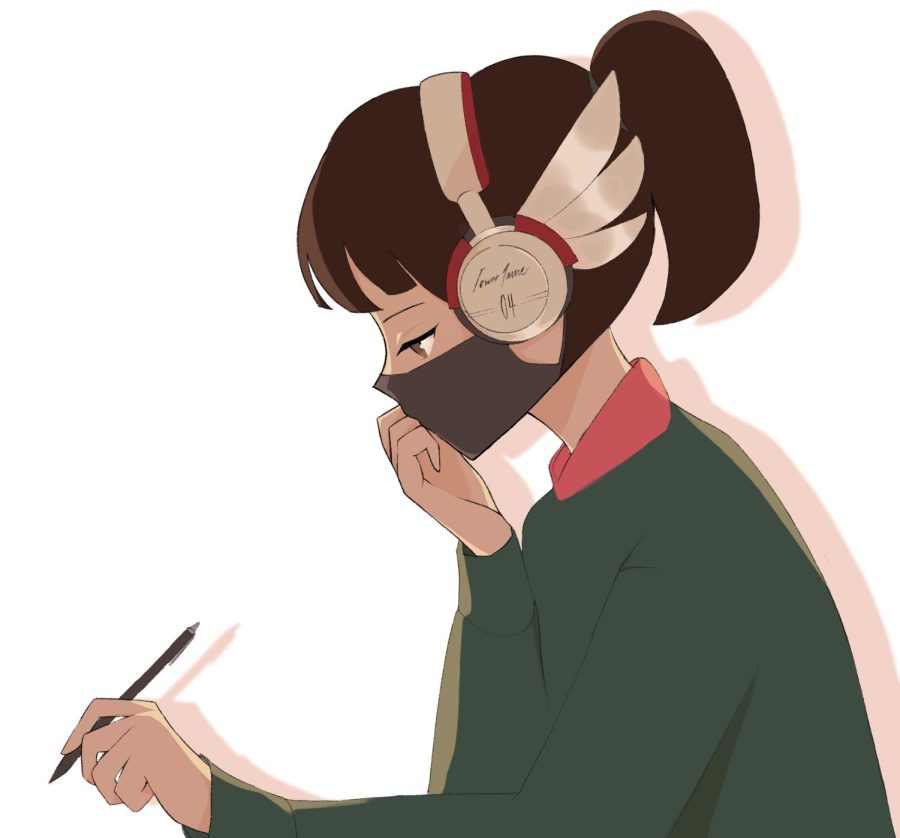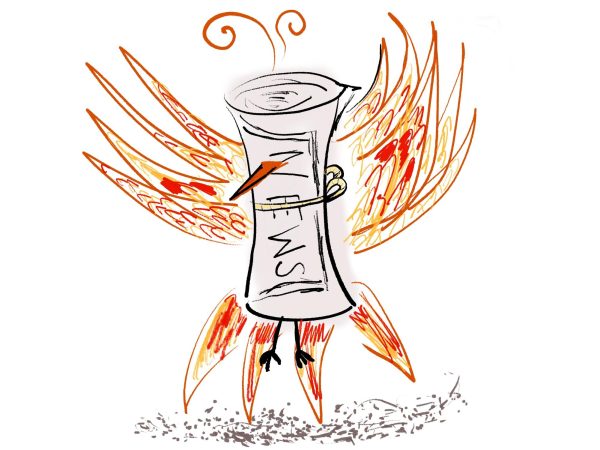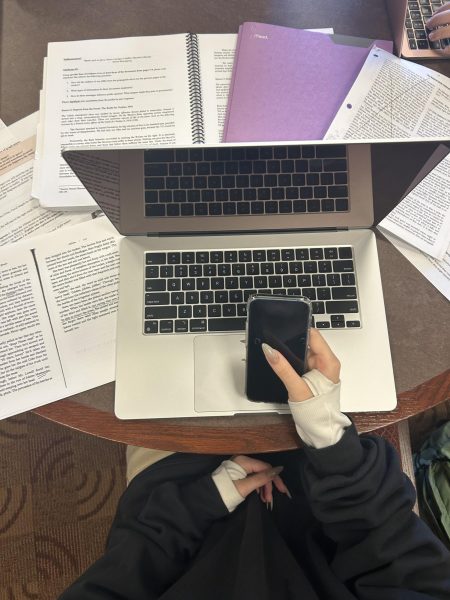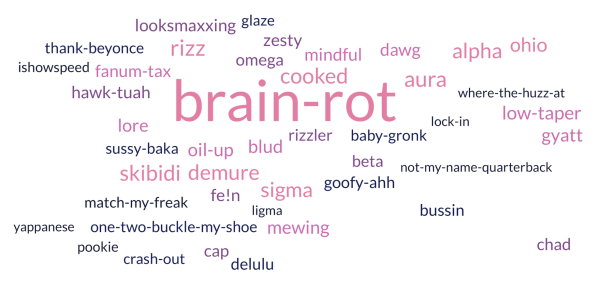Listening in on Lo-fi
An Exploration on Lo-fi and Contemporary Study Music
In popular Lo-fi channel ChilledCow’s famous “beats to relax/study to” stream, “Lo-fi girl” scribbles in her notebook endlessly. Many studiers tuning into the stream may see themselves in the Lo-fi girl.
It is late in the evening on Sunday. A stack of homework lies on your desk. Yet despite the stress and urgency to complete all of your assignments, a tranquil ambience washes over you as Lo-fi music plays in the background.
Lo-fi, as defined by musician Eric Matthews, is short for “low-fidelity,” a type of music that captures the imperfections of the recording or production process. As Director of Instrumental Music Mr. Robert Anderson put it, “The Lo-fi descriptor refers to certain subtle ‘defects’ in the music, such as tape hiss, flutter, or any traditionally unwanted background noise.”
However, rather than viewing these imperfections as flaws in the track, fans of Lo-fi embrace these mistakes as a defining characteristic of the genre. For Jazzy Joseph (‘23), “One might think that the imperfections detract from the quality, but I think they actually contribute to Lo-fi’s ‘home-like,’ comforting aesthetic. When a song feels raw, it gives off the natural feeling of live music, and since the sounds remain un-processed, the songs sound like they are being played in a room around you and the band is right there.” Jazzy thinks that the realistic imperfections could be why Lo-fi feels so comforting.
Though it has existed for a while, one might wonder why Lo-fi music has exploded in popularity only in recent years. Lo-fi YouTube channels such as ChilledCow are not only well-known, but also have established communities of listeners worldwide. ChilledCow currently has 9.6 million subscribers and has thousands of listeners on its famous “beats to relax/study to” stream at any given moment.
Lo-fi’s popularity can also partly be attributed to social isolation during the COVID-19 pandemic. At the start of the pandemic in March, the channel ChilledCow gained 340,000 subscribers, which is over twice the 160,000 new subscribers it saw in January 2020. Although Lo-fi music styles have been around for decades, isolation has allowed younger generations to ‘discover’ the hip-hop type beats that Lo-fi is based on. Lo-fi styles have been especially popular among students who have gravitated towards it as a form of study music.
History and Social Sciences Chair and psychology teacher Ms. Karri Woods, who is a Lo-fi fan, explained, “When you’re sitting and listening to Lo-fi, there’s usually a fairly steady beat that’s going on… [Y]our body naturally moves and sways to it because our brains automatically predict the progression of a beat.” From a psychological perspective, the consistent beat in Lo-fi styles is a part of the reason why Lo-fi is great for studying. Steady tempos help “lull us into a place of concentration,” Ms. Woods said. “If the beat were really wild and inconsistent, it would be harder for us to focus.”
According to Ms. Woods, there are a few more criteria for finding the most effective study music. “Most songs layer in sounds and lyrics that are designed to grab your attention. But when you’re studying, you want music that minimizes the amount of attention it’s grabbing from you,” she explained. Some of these attention-grabbers include lyrics, high, irritating frequencies, and irregular rhythms. The lyric-less, low-pitched, steady beats of Lo-fi are thus an excellent candidate for an optimized studying experience.
There is also a difference between what our brain perceives consciously and unconsciously. “Our feelings, mood, body, and heartbeat are subtly influenced by the sounds we are hearing,” said Ms. Woods. Lo-fi producers intentionally include imperfections in their compositions, including misplayed notes and degraded audio signals, which may subtly surprise and engage your unconscious brain,” she said. “Many people are able to maintain focus on an effortful task like studying while listening to LoFi music because the melody and layering of subtle environmental sounds that would usually be edited out makes the music aesthetically interesting, but not so interesting that it distracts you from the task at hand.
Jazzy, who also produces music as a hobby, described Lo-fi’s charming similarity to R&B styles. “The chords are super similar,” she explained. “They use a lot of seventh and ninth chords to create that ’smooth,’ ‘jazzy’ feel. If one were to sing over a Lo-fi track, they would practically have a whole R&B song. I think Lo-fi is really special because it attracts attention to the beautiful art of music production, which is usually overshadowed by vocal performance.”
Director of Choral Music Dr. Christine Micu agreed with Jazzy’s sentiment. Dr. Micu expressed that Lo-fi remains “a music of the people,” despite the drastic evolution it has undergone since its humble, musical beginnings. Because anyone can make it, she explained, “it did not have to be highly produced or perfected like music that is sold as ‘professional.’”
While studying, Grace Sun (’23) listens to various types of music, including Lo-fi versions of TikTok hits, classical music, movie and game background music, and instrumentals of pop songs. Grace said, “I like these because they aren’t distracting but they all have tunes that I can ‘vibe’ peacefully to.” However, Grace finds that specific subject areas have varying compatibility with study music. “For some reason,” she said, “I only listen to music when I do the arts or humanities. I find that I cannot concentrate even with quiet music during subjects such as math or science.”
English teacher Dr. Clark also only listens to music under certain circumstances. “Personally, I like listening to music while I grade and write emails, but I prefer silence when I’m working on longer creative writing projects. Experimenting with different sound environments for different types of work has been helpful for me,” she explained.
Dr. Clark also encourages students to take time to test out various soundscapes, including silence, to see what may work best for them. “I do think that sometimes silence can be helpful,” she said. “While our first instinct might be to experience silence as uncomfortable or empty, it can be useful for diminishing distraction once you’re absorbed in the task at hand. I think this goes for writing especially. While I know most students prefer to listen to music while they write and study, I’d encourage them to experiment with occasional silence, particularly if they feel like their current routine isn’t working for them.”
As described by Discover Magazine, “hip hop beats” like Lo-fi are “the contemporary heartbeat of society.” It seems like Lo-fi styles will continue to beat on in the hearts of many students around the world, wooing hardworking students with the promise of soothing background music, and focused and productive homework sessions.

Shirley Xu is a junior and this is her first year on The Tower. She has been a writer since the ripe age of three, and is excited to share her journalism...











